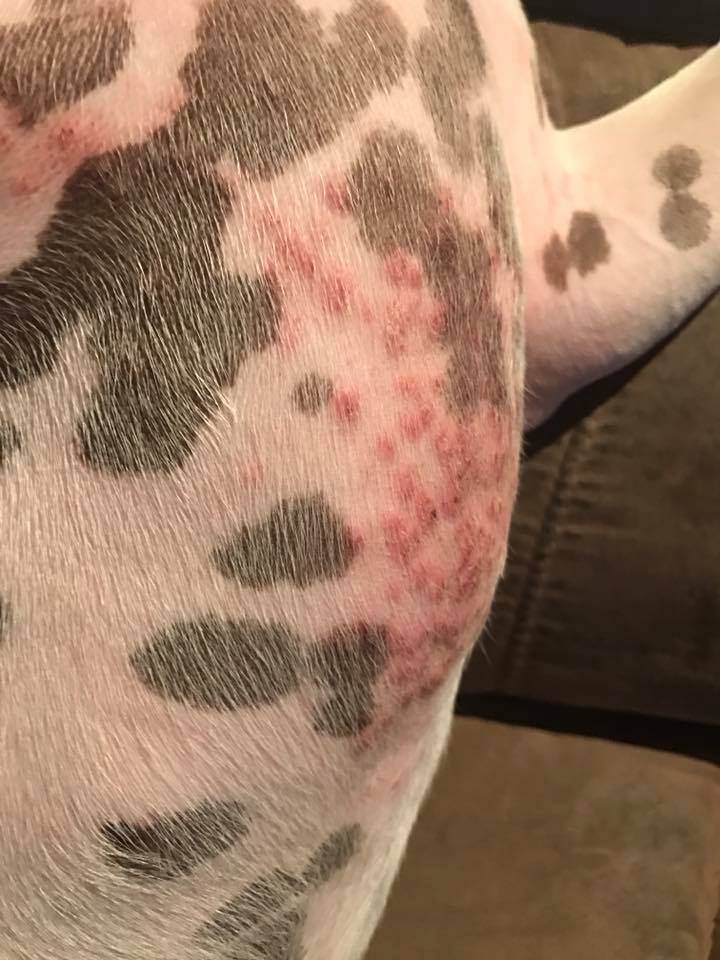Itchy Dogs: Pyoderma
/What is Pyoderma?
Pyoderma is a commonly treated skin condition in dogs. Pyoderma literally means pus in the skin, and is characterised by a bacterial infection of the epidermis (skin) and hair follicles.
Your dogs skin will always have a low level of staphylococcus and other bacteria on its surface, and in normal situations the skins defence system prevents the bacteria entering the epidermis and hair follicles. When these natural defences are broken it allows the bacteria, often staphylococcus, to enter the epidermis and cause infection.
Example of pustules/papules that can occur when the skin is infected.
The skins defence system can be broken in many ways including a disrupted immune system, small abrasions in the skin and moist skin. The immune system plays a large role in this disease so dogs with hormonal imbalances (thyroid issues or Cushing disease), allergies and other systemic diseases can end up with severe pyoderma.
Pyoderma is rarely a primary disease, meaning there is another disease process that has lead to the skin infection. This can be something as small as a missile bite the that causes some itching, breaking the skin barrier and allowing bacteria in. Or it can be much more complex - like cushings disease which leads to a lowered immune system and subsequent infections.
Symptoms
The symptoms of pyoderma reflect what is happening in the skin. The hair follicles are infected, which often causes the hair to fall out resulting in spots of alopecia (missing fur). Because the epidermis is also infected dogs with pyoderma often have small pimples, pustules, papules, rashes and sores on their skin. It is generally the skin of the sides, belly armpits and inner things that is affected.
Diagnosis
The first step of diagnosing pyoderma is assessing the dog clinically and physically for symptoms of the disease. Your veterinarian should then take a skin tape, scrape or impression smear to identify the types of microbes involved in your dogs skin infection. Many dogs will have an overgrowth of staphylococcus bacteria, but some will also have concurrent yeast infections and takin akin samples helps rule out primary causes of pyoderma like mites.
if your dog gets recurring infections your vet may recommend blood testing to detect hormone diseases or even further skin testing to idenfitfy the type of bacteria involved. Methilin-resistant staphylococcus is becoming more common in pyoderma infections and will not respond to traditional treatments.
Treatment
Generally pyoderma is treated with oral and topical antibiotics. I usually start with a cephalosporin-family antibiotic and treat for a minimum of four weeks. Often a two week course is not enough to clear the infections from the skin, and with in weeks the dog is back at the vet again with same condition, and this can lead to resistant bacteria hat is even harder to kill.
I also like to use a medicated shampoo. If it is a primary bacterial infection I will use a chlorhexidine based shampoo, if there is also yeast I will use a shampoo with an antifungal such as miconazole as well as chlorhexidine. The most important thing with the shampoos is that they are used twice weekly in the early stages of infection and left on for ten minutes. With out ten minutes contact time they will not work!
If your dog has received treatment and not responded it may be because there is another underlying cause that needs to be addressed. Further testing and treatment of the underlying cause will help resolve the pyoderma. It can also be because they are infected with a more resistant bacterial strain, performing a culture of the skin can help identify the bacteria and which antibiotic will kill it.
Prevention
There is no sure fire way to prevent pyoderma but a great start is ensuring your pet has a good diet. A diet high in omega oils and with good nutritional value will make a big difference in helping the skins immune system fight infection. I highly recommend looking into specially formulated skin diets to try increase the fatty oil content, or alternatively consider supplementing your dog with fish oil tablets (I usually give a 1000mg human tablet per 15kg of dog but the dose range varies hugely).
I also recommend using a medicated shampoo long term for susceptible dogs. These shampoos are harsh on the skin so once infection is under control I recommend using it once a fortnight just to maintain lower bacterial loads on the skin.
Controlling the underlying cause for pyoderma is the most important step in preventing its recurrence, I highly recommend doing further testing such as skin biopsies, blood tests and allergy tests if your dog gets repeated infections. Although it may seem costly and time consuming it may save you money in the long run when you get a diagnosis for WHY your dog is getting pyoderma. Not too mention it will keep your pooch happier and healthier!
If you have tried tried other methods that have worked well for your pup please comment below!
In the following weeks I will try to cover all there is to know about the diseases that cause skin issues in our doggies.
If you love adventure and dogs check out our VLOGs. This episode we go sailing to a nearby island in Panama and I assist with a complex fracture repair in an old dog.


